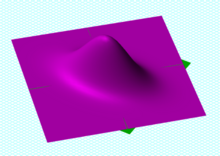
Back مصفوفة تغاير Arabic Matriu de covariància Catalan Kovarianční matice Czech Kovarianzmatrix German Matriz de covarianza Spanish ماتریس کوواریانس Persian Matrice de variance-covariance French Kovarianciamátrix Hungarian Matrice delle covarianze Italian 分散共分散行列 Japanese
| Part of a series on Statistics |
| Correlation and covariance |
|---|


In probability theory and statistics, a covariance matrix (also known as auto-covariance matrix, dispersion matrix, variance matrix, or variance–covariance matrix) is a square matrix giving the covariance between each pair of elements of a given random vector.
Intuitively, the covariance matrix generalizes the notion of variance to multiple dimensions. As an example, the variation in a collection of random points in two-dimensional space cannot be characterized fully by a single number, nor would the variances in the and directions contain all of the necessary information; a matrix would be necessary to fully characterize the two-dimensional variation.
Any covariance matrix is symmetric and positive semi-definite and its main diagonal contains variances (i.e., the covariance of each element with itself).
The covariance matrix of a random vector is typically denoted by , or .
© MMXXIII Rich X Search. We shall prevail. All rights reserved. Rich X Search







